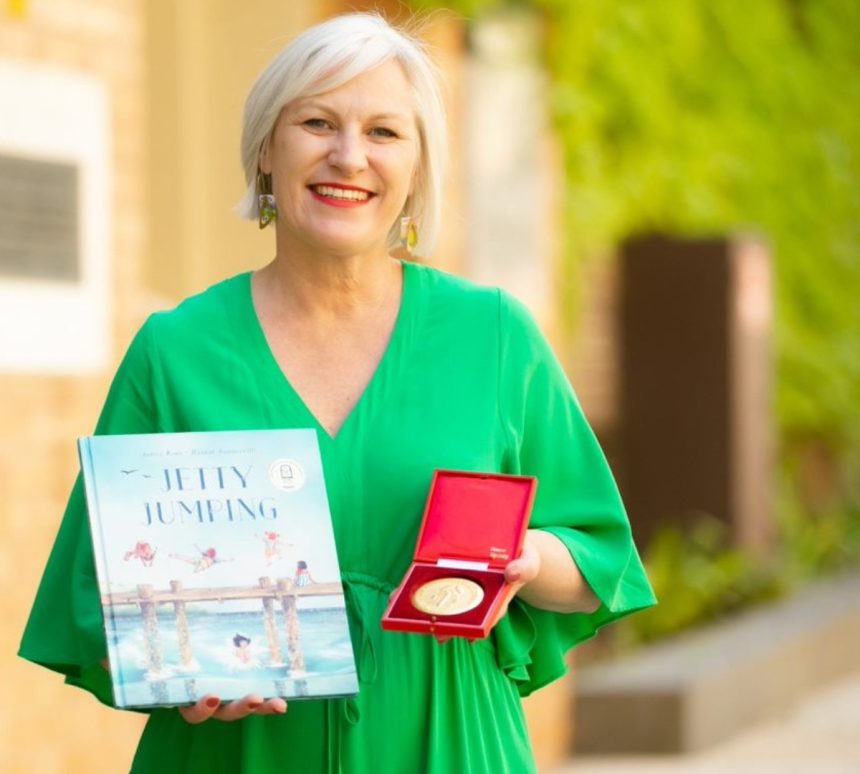Picture book author Andrea Rowe has always loved writing for children.
“It stems back to writing National Park interpretation for families to explore the environment,” she says.
But since evolving from a professional life spent copywriting for brands and businesses, to becoming an award-winning author and visiting author at primary schools across the country, Ms Rowe says “helping young readers understand and connect with a setting, issues, and themes and feel a sense of agency over how they can interact really excites me”.
Having been the editor and content writer for kids’ clubs and creating youth content and learning resources for organisations such as the Royal Flying Doctors Club, and Parks Victoria’s Junior Rangers, as well as Kids Teaching Kids and youth-focused media, the ‘leap’ to children’s picture book writing, she says, was more like “a simple step sideways”.
Becoming a writer starts by being a reader
As a child, her own reading memories centred around stories that mirrored back a familiar Australian landscape, “which is probably why.” she says, “I am continually drawn to the works of Margaret Wild, Alison Lester, and Bob Graham, and the classic works of May Gibbs Meet Snugglepot and Cuddlepie, Robert Roennfeldt Tiddaluk, Norman Lindsay’s The Magic Pudding and Dorothy Wall’s Complete Adventures of Blinky Bill“.
“I felt I was travelling through story time scenery and across landscapes that I intimately knew,” says Ms Rowe, whose debut picture book, Jetty Jumping, won the 2022 Children’s Book Council of Australia Award for Early Childhood Book of the Year.
“But my memories are also connected with family together-time and having fun with imagination and creativity. My parents read to us all the time and we were invested in stories as kids.”
As a parent herself, Ms Rowe was drawn to books like Alison Lester’s Magic
Beach to read to her own children.
“I raised my kids on salt water and sand, and it was our special story,” she says.
Sandy Beach by Bob Graham is a close second in her eyes, and “for read aloud fun”, she names Where the Wilds Things Are by Maurice Sendak and The Gruffalo by Julia Donaldson “pure story time pleasures”.
“I also adore The Lorax by Dr Seuss,” she says. “They were stories my own children reached for reading and imagination pleasure.”
To help today’s teachers connect their own young readers to Ms Rowe’s stories, teacher notes for both Jetty Jumping and her latest picture book, Sunday Skating, help form deeper connections with the texts.
In Australia, many teachers also work as writers – penning everything from junior fiction to true crime for adults. When it comes to sharing words of wisdom for budding picture book writers, Andrea Rowe is a big fan of being brave enough to take the plunge and just doing it. EducationDaily asked her for 10 tips that might help.
- Invest in yourself. Save your coffee and dinner’s out money for membership and workshops in the industry.
- Listen to the professionals in publishing, writing, illustrating and bookselling.
- Read books constantly. Borrow them from the library or lurk in the bookstores.
- Pay careful attention to the books you most adore and who publishes them – they may be the publisher that you are most drawn to.
- Be open to feedback and also rejections – picture books become better reading material with a team of people like editors, publishers, designers who want the best for your book.
- Hang out with other kidlit authors – that might mean heading to book launches, turning up to conferences and attending library talks, but it’s also a part of building your knowledge about the industry.
- Follow book reviewers online and see what they are talking about – they have their finger of the pulse of picture book successes and next big things and are so generous with their book wisdoms and sharing.
- Make time to write. No picture book will be written to the best it can be if you are not sitting at the desk, doing the work, adapting the text, refining the characters and pushing yourself forward with exploring a theme. You need to create dedicated writing time.
- Put yourself out there. That might mean turning up to a tutorial or workshop with experiences professional – trust me – they aren’t scary at all and are over the top helpful and generous with knowledge.
- Hang out with kids. Picture books are for them after all. If you don’t have little people, volunteer with an organisation or just listen in on passing observations – you’ll be absorbing what matters to them, their phrases and language, and their emotional milestones that they are moving though – it’s picture book gold!







